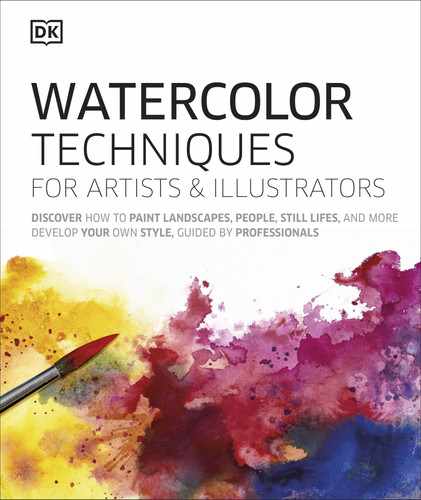
110 Intermediate | TECHNIQUES
USING V AND Z SHAPES
Your painting must have a
background, a middle distance,
and a foreground to succeed.
To balance the composition, this
painting relies on the strategy
of using “V” and “Z” shapes.
Balanced composition
CREATING STRUCTURE AND SHAPE
Whether you are painting a landscape, gures (see p.112–113), or other subject,
a good structural composition will engage the viewer. The “rule of thirds” (see
right) is one classic technique. Another is to use alphabet letters, such as L, V, Z,
C, T, and S, as compositional shapes. You do not need to paint objects to lead
the eye—colors, tones, and individual shapes provide just as much interest.
Cumbrian hills, England
No. 15 and no. 10 soft-hair
mop brushes
No. 10 stiff-bristle round brush
No. 5 soft-hair round brush
22
1
/2 x 15 in (56 x 38 cm)
cold press 140 lb (300 gsm)
watercolor paper
You will need
1
Initial sketch
For a valley amid steep mountains,
a “V” structure is ideal. Also, a strong “Z”
composition connects the foreground
stream, the middle-distance rocks, and
the background mountain.
2
Background wash
Dampen the paper with the no. 15
mop brush, leaving areas untouched. Mix
Prussian blue, vermilion, and a little raw
sienna to paint the sky and carry the
wash over the ground. Add a touch of
lemon for the valley in the wet wash.
Vermilion
French ultramarine
Prussian blue
Cadmium lemon
Burnt umber
Raw sienna
US_110-111_Balanced-composition.indd 110 02/04/2020 3:34pm

111 Balanced composition
Selecting your scene
Even a scenic landscape can struggle
to interest the viewer without a good
composition, whereas an apparently
mundane view can make an exciting
painting if the composition is strong. The
rule of thirds involves dividing a picture
into thirds and placing a focal point where
the thirds intersect. Finding other shapes
to lead the eye will help you arrive at a
scene that will engage the viewer’s eye.
3
Dene the shapes
While the paint is still wet, lift out
the road and stream with a dry brush
to connect the white areas and form a
“Z” composition.
4
Strengthen shapes and tones
Paint the rocks wet-on-dry. Give the
middle and foreground a wet-in-wet
wash of ultramarine, lemon, and umber.
5
Balance the color
Add cloud shadows, wet-in-wet,
with umber, ultramarine, and lemon to
the upper part of the mountain on the
right to balance the composition.
The rule of thirds
Make sure the scene has a focal point
for the eye to travel to, placing it at
the intersection of thirds rather than
in the center.
Connecting the shapes
Find a connection between the main
shapes. The simplest way here is to use
the stream, the distant road and the
mountains for a hidden “Z” shape.
US_110-111_Balanced-composition.indd 111 02/04/2020 3:34pm

112 Intermediate | TECHNIQUES
Figures in harmony
USING AN S-SHAPED COMPOSITION
The compositional technique of following an “S” shape has been
used in this painting to add intrigue and keep the viewer looking
at the piece longer. This is a more interesting and dynamic way to
arrange multiple gures than placing them all standing together.
Here the gures, faces, and limbs create the shape.
No. 1 soft-hair mop brush
No. 1 soft-hair round brush
Sketchpad
Masking uid
11 x 15 in (28 x 38 cm) rough
300 lb (425 gsm) watercolor paper
You will need
Apply masking uid
in a thick layer to
ensure that it can be
removed easily
Vary the weight
and size of the
lines to ow
down the fabric
2
Sketch and mask the highlights
Once you are condent about the composition,
draw it on your watercolor paper. Using the
wooden end of a paintbrush, apply masking
uid to the highlights of folds on the fabric
and high points on the lighter gures.
“A dynamic composition can be
both simple and powerful if the
forms and angles work well.”
1
Planning out the composition
Achieving the correct angles is crucial to the success of this owing
composition, so begin by making a drawing. Start with the “S” shape
shown here, which will become the line around which you place your
elements. Use the limbs of the gures to follow the sketched line as
closely as possible while still being believable in their angle. Vary the
heights of the gures so you can follow the shape. Next, map out the
areas of darker tone.
Dark areas
(blue) balance
the composition
Main “S” shape (pink)
leads the eye round
Limbs and dress
folds (purple)
point to “S” shape
Filling the frame (green)
grounds the composition
Gaze of gures
(yellow) reinforces
“S” shape
Venetian red
Indian yellow
Yellow ocher
French
vermilion
Ultramarine
deep
Payne’s gray
Quinacridone
red
US_112-113_Balancing_composition_2.indd 112 02/04/2020 3:34pm

113 Balanced composition
3
The rst skin tones
Using the mop brush, mix very dilute
skin tones and apply in at layers. Allow the
washes to dry completely before painting
adjoining areas.
5
Darker details
Make a thicker mix of the darkest tone
using blue and gray and apply with the round
brush, using as few strokes as possible. Finally,
remove the masking uid.
4
Deeper tones and shadows
Work from the lightest remaining tone, in
this case the background, to the darkest. For
shadows on the gures, overlay the same
light skin tone used in the previous step.
US_112-113_Balancing_composition_2.indd 113 02/04/2020 3:34pm
..................Content has been hidden....................
You can't read the all page of ebook, please click here login for view all page.
